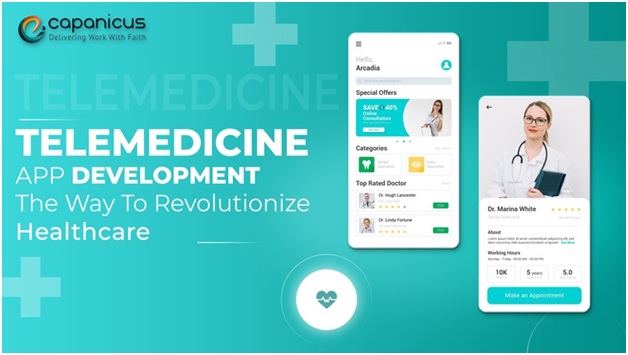What is a Telemedicine Software?
Telemedicine software is a platform that enables medical professionals to provide advice without physically seeing the patient. Through video conferences, they can review electronically provided medical reports or look at the visual features of the problem. In the process, messages and audio are also used. Patients can remain in the comfort of their own homes while doctors operate from their offices. It may be used on a computer, tablet, or smartphone and is useful for controlling common ailments, chronic conditions, and even follow-up. There is much that telemedicine can address.


Healthcare providers must digitize to lower costs and enhance patient satisfaction, just like any other company. One digital tool that healthcare professionals should use to digitize their services is the telemedicine platform. Software for telemedicine increases access to healthcare. It makes it easier to work with patients who struggle to get to their appointments because of limited transportation alternatives or mobility challenges, and it allows them to forgo traveling for checkups. Platforms for telemedicine are essential for healthcare providers looking to make cost reductions.
Here are the benefits of a telemedicine platform during an illness:
Telehealth saves time, and patients like it. It’s more straightforward. Additionally, it lessens their contact with other ill patients. Patients can communicate with their physician from any location, including home or work. The biggest advantage is that telemedicine leads to better patient outcomes.
(A) Quicker Attention
Nothing takes more time out of a hectic schedule than a trip to the doctor. In addition to the time it takes them to get to and from the healthcare provider’s office, patients may find themselves waiting for hours.
Travel is not necessary thanks to telehealth, which also shortens patient wait times. Additionally, patients receive care more quickly and can begin treatment sooner if they have symptoms that can be reliably detected remotely, such as a sore throat or rash. When beginning the use of a drug that requires monitoring (such as the majority of ADHD meds), individuals can use an app or website to report their outcomes.
(B) Diminished Level of Exposure
Nobody wants to have a checkup at the doctor and return home infected with a virus they picked up in the waiting area. COVID-19Even now, 19 surges frequently pack hospitals and doctor’s offices. Patients can receive the care they require through telehealth without having to worry about catching a new disease and infecting their friends, family, or coworkers.
(C) Privacy And Comfort
Patients can receive care for non-emergency conditions from the convenience and seclusion of their own homes with the use of telehealth software. They can have a video chat consultation with a doctor or have their condition monitored remotely. Patients with disabilities who might find it difficult to travel to a clinic benefit from telehealth. It relieves these patients of the mental and physical burden of having to go to a doctor in person.
Plus, telemedicine provides the highest level of privacy. It is not a concern for patients with delicate ailments to be observed going into or coming out of a specialist’s office.
Type of telemedicine solutions:
While virtual visits have been our primary focus, telehealth has a wide range of other uses and applications. Here are some additional instances.
1. Online pharmacy services: Prescription orders and refills can be placed online by patients using pharmacy management systems. Additionally, patients can receive additional information on the drug they’re taking through virtual consultations with a chemist.
2. Chronic Conditions Management: Patients can provide important information like their heart rate, pulse, and blood sugar levels to healthcare doctors immediately by using electronic medical record (EMR) devices. In response, they can examine this data to determine when vital signs deviate from the norm and notify patients in the event of an emergency.
3. Concussion Recovery: Using values entered into a computer-based simulation system, physical therapists and orthopedists can utilize concussion recovery solutions to record and evaluate a patient’s physical and psychological performance.
4. Remote Patient Monitoring: Care providers can keep an eye on vital signs like blood pressure, heart rate, weight, blood sugar, and temperature via telehealth technologies. The technology notifies the remote care staff whenever there is a deviation in the patient data from the norm.
5. Medication Monitoring: To keep an eye on the effectiveness and usage of medications in both adults and children, medical facilities employ telehealth services.
6. Mental Health Therapy: By reducing potential triggers from in-person visits, virtual visits can assist individuals with mental health illnesses in receiving counseling and therapy from home.
The use of telemedicine apps is a must, not optional. Why?
Due to its widespread use—particularly during the COVID pandemic—telemedicine is now so widely accepted that it is no longer just a choice for physicians to think about; rather, it is now required for all medical facilities to remain competitive and to reap the numerous advantages we have already mentioned.
The use of telemedicine services increased significantly during the COVID pandemic. According to research, the analysis demonstrated that in April 2020, consumption had increased by an astounding 38 times. This peak reached 32% before leveling out at 13–17%.
Healthcare facilities proactively choose to use telehealth services by utilizing cutting-edge hardware and software. The skills of capanicus app developers are the only factors determining an application’s functionality and quality. To create your telemedicine app, you need to pick a telemedicine platform development company. The success of your virtual healthcare endeavor is determined by their knowledge, experience, and availability of resources.
Conclusion
Telehealth is here to stay, even though the pandemic increased its use and popularity. The ease of use that telehealth provides is preferred by both patients and medical professionals.
A multitude of opportunities for entrepreneurs arise with the growing significance of information technology in healthcare. Speak with a software development company with experience creating applications comparable to yours if you require or have a concept for telehealth software.
A skilled healthcare software development business can evaluate your requirements and provide affordable options to help you accomplish your objectives. They can also enlighten you about functions and features that you might not have thought of.









